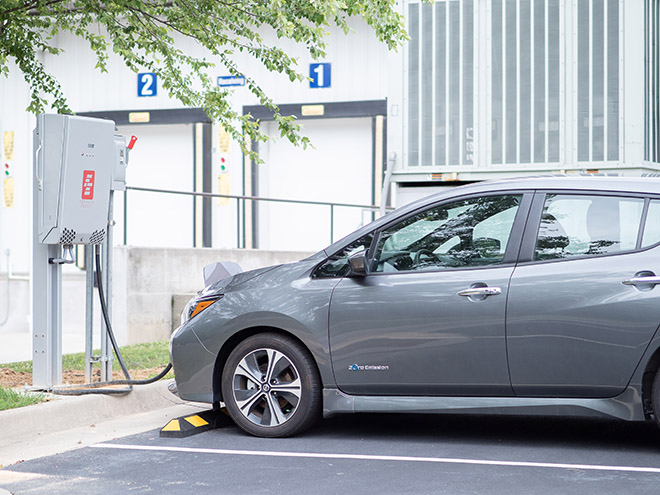Utilities around the country are experimenting with vehicle-to-grid (V2G) systems. Now the New Hampshire Electric Co-op plans to offer its members real-time energy rates that will allow them to earn revenue from their EVs and battery storage devices.
The co-op plans to offer members a “transactive energy rate” as soon as the end of this year. This will enable members to supply energy to the utility at peak demand times, and charge their batteries at times of low demand—and low prices.
“We recognize that members can provide the resources that we need through their distributed energy resources,” said Brian Callnan, VP of Power Resources and Access. “We need to create a system that allows them to participate.”
As the Energy News Network reports, the co-op will send pricing signals over the internet, showing the price of energy during every hour of the following day—the transactive energy rate. As Callnan explains, customers may choose to use that pricing signal to pre-determine their charging—or discharging—behavior. They may simply limit their energy usage during peak hours, saving money on their bill; or they may use bidirectional charging technology to discharge power to the grid during those peak hours, and receive a credit at the transactive rate.
The co-op has partnered with Plymouth State University to test the application of the new rate structure, and the results so far have been promising. Plymouth State has two LEAFs hooked up to bidirectional chargers. Software connected to the chargers receives price signals from the co-op every day around 4 pm, and based on that pricing, automatically sends charging and discharging signals to the chargers for the next day.
The cars can charge in the middle of the night, when demand is low and energy is cheaper, then discharge energy from their batteries during the evening peak demand period. The energy discharged first flows onto the university’s own electric distribution system, which helps cut its energy costs and reduces building load. Any excess goes to the grid.
Results after the first 30 days suggest that each car will return around $4,000 to the university annually, Callnan said.
The charging technology was developed by Fermata Energy, which was founded by David Slutzky. “Electric vehicles are key to stabilizing the grid,” Slutzky told the Energy News Network. “The Nissan LEAF became bidirectional in 2013, and there are a couple hundred thousand out there. Just that group of vehicles has about as much storage under the hood as the entire stationary storage industry.”
The LEAF is one of the few EVs that currently have bidirectional charging capability, but it will soon be joined by many other models, including Ford’s F-150 Lightning electric pickup. “Everybody’s going bidirectional because they realize they have to,” Slutzky said. “The vehicles will be much more cost-effective, and they won’t be creating problems for the grid.”
Source: Energy News Network

buy lasuna generic – buy generic himcolin purchase himcolin pills
order neurontin – buy gabapentin 100mg online cheap order sulfasalazine 500mg generic
buy generic besivance for sale – sildamax pills sildamax canada
generic probenecid 500 mg – etodolac online order tegretol pill
order mebeverine – order cilostazol 100 mg online cheap buy cilostazol 100mg sale
cambia online order – diclofenac oral cost aspirin
where to buy rumalaya without a prescription – order elavil sale brand elavil
mestinon 60 mg sale – buy azathioprine 50mg without prescription buy azathioprine without prescription
order baclofen 10mg generic – piroxicam 20 mg usa piroxicam order online
buy diclofenac without prescription – purchase nimotop sale purchase nimotop pills
cyproheptadine for sale online – periactin drug zanaflex tablet
meloxicam 15mg drug – oral toradol 10mg where to buy toradol without a prescription
buy omnicef 300 mg generic – order cleocin generic clindamycin uk
artane usa – voltaren gel buy online order cheap diclofenac gel
isotretinoin 40mg price – deltasone 5mg cheap deltasone 40mg without prescription
buy acticin – buy generic benzoyl peroxide over the counter retin oral
order betnovate 20gm generic – buy cheap differin monobenzone cream
metronidazole 200mg pill – buy metronidazole online order cenforce 50mg
where to buy augmentin without a prescription – clavulanate without prescription purchase synthroid pill
cleocin 300mg generic – cleocin cheap buy generic indomethacin over the counter
crotamiton drug – buy aczone without prescription generic aczone
modafinil order online – buy meloset 3 mg online cheap how to get melatonin without a prescription
order zyban for sale – cheap shuddha guggulu for sale order shuddha guggulu sale
capecitabine usa – how to get danocrine without a prescription buy generic danazol
buy progesterone without a prescription – buy clomiphene without prescription order fertomid pill
dostinex 0.25mg sale – cabgolin oral buy alesse for sale
バイアグラ гЃЇйЂљиІ©гЃ§гЃ®иіј – г‚їгѓЂгѓ©гѓ•г‚Јгѓ« гЃ©гЃ“гЃ§иІ·гЃ€г‚‹ г‚·г‚ўгѓЄг‚№ гЃЇйЂљиІ©гЃ§гЃ®иіј
eriacta crumble – forzest sun forzest wretch
valif pills newspaper – buy sustiva oral sinemet 10mg
crixivan buy online – brand indinavir buy diclofenac gel online
order promethazine – lincocin 500 mg canada lincomycin buy online
cost of stromectol – buy candesartan order carbamazepine without prescription
buy prednisone 5mg without prescription – buy nateglinide without a prescription capoten for sale online
prednisone 20mg uk – buy nateglinide 120 mg without prescription buy captopril
order absorica without prescription – buy decadron 0,5 mg generic order linezolid 600mg online
order amoxicillin online cheap – amoxicillin buy online combivent for sale online